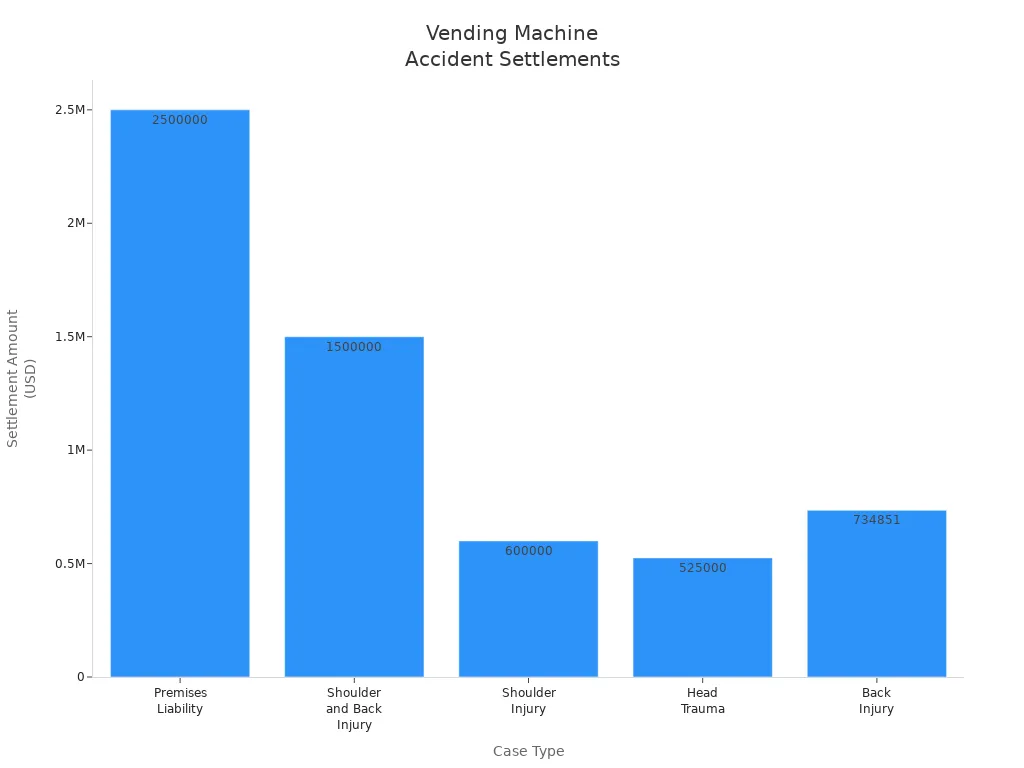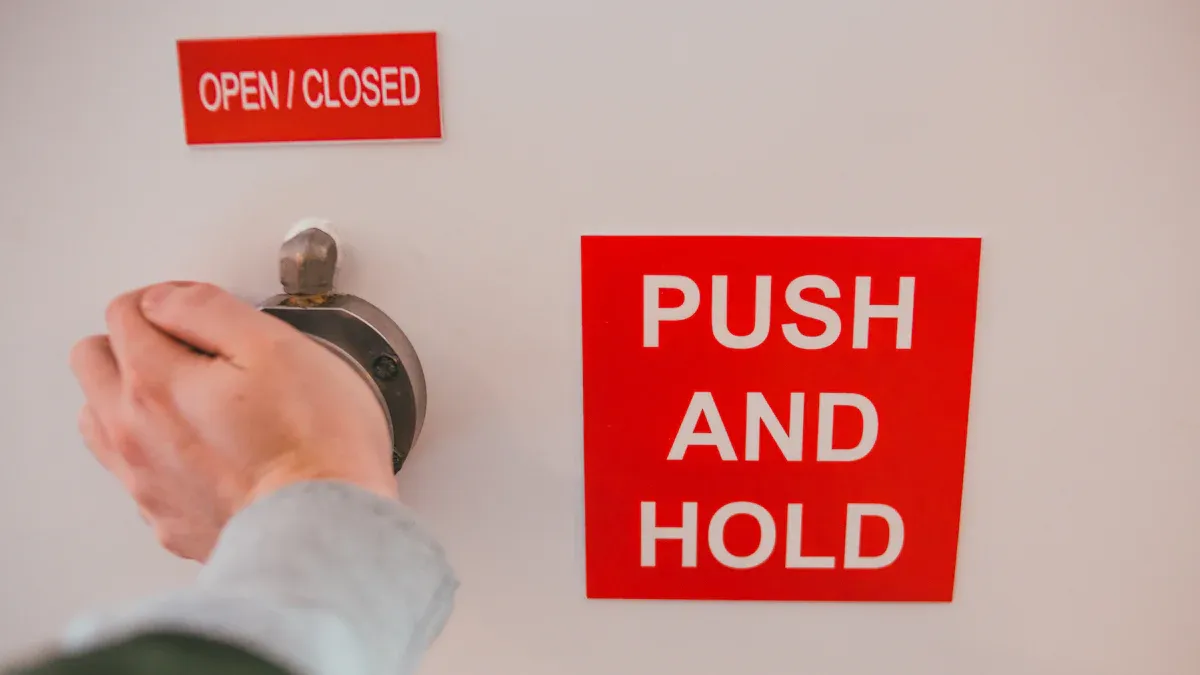The Hidden Dangers of Vending Machines: A Closer Look at Fatal Accidents

You might think vending machines are harmless, but the dangers are real. Each year, vending machine accidents kill about four Americans, making these machines twice as deadly as sharks. Some vending machines weigh over 1,000 pounds, and tipping remains the main cause of fatal injuries. The yearly risk of dying from a vending machine accident stands at 1 in 112 million. The Hidden Dangers often go unnoticed until tragedy strikes.
Key Takeaways
Vending machines can be dangerous. Each year, they cause about four deaths in the U.S. due to tipping and misuse.
Young adults, especially males, are at the highest risk for vending machine injuries. Stay cautious when using these machines.
Always ask for help if your snack gets stuck. Shaking or rocking the machine can lead to serious injuries.
Check food packaging and temperature before consuming items from vending machines. This helps prevent foodborne illnesses.
Look for safety features like smart sensors and contactless payments in modern vending machines. These can reduce risks.
Hidden Dangers
Why Vending Machines Are Risky
You may not realize how many risks surround vending machines in public spaces. These machines look harmless, but the hidden dangers of vending machines can surprise you. Many people focus only on the obvious dangers, like tipping, but there are more risks you should know about.
Here are some of the most common reasons vending machines are considered risky:
Theft and vandalism often happen when machines sit in unsupervised areas.
Maintenance challenges can cause machines to break down or become unsafe.
Health and safety concerns arise when food is not stored properly.
Compliance issues may lead to fines if machines do not follow local laws.
Technical malfunctions, such as broken payment systems, can frustrate you and cause financial loss.
The mechanical and physical features of vending machines also add to the risks. Take a look at this table:
Mechanical/Physical Feature | Associated Hazard |
|---|---|
Lack of tamper-resistant designs | Increases risk of physical theft and vandalism |
Inadequate surveillance | Allows malicious activities to go unnoticed |
Vulnerabilities in cash handling systems | Exposes machines to cyber threats and data breaches |
You face these risks every time you use a vending machine, especially if you do not pay attention to your surroundings.
Overlooked Hazards
Many hidden dangers of vending machines go unnoticed. You might think you are safe, but these dangers can catch you off guard. Here are some overlooked hazards:
Tipping accidents happen when machines are not secured properly.
Misuse, like shaking or rocking the machine, increases the risk of injury.
Psychological biases make you underestimate the risks and feel too safe.
Poor hygiene can lead to foodborne illnesses.
The unattended nature of machines raises the risk of microbial contamination.
Environmental factors also play a role in the risks. For example, machines placed in low-traffic areas face more theft and vandalism. Restricted access hours can limit safety checks. Narrow hallways or poor loading zones make restocking harder and less safe.
You need to stay alert to these hidden dangers. The risks are real, and knowing about them helps you avoid serious safety risks.
Fatal Accidents

Statistics and Frequency
You might not expect it, but fatal accidents involving vending machines have happened more often than you think. These machines look safe, but the dangers can be deadly. Since 1978, at least 37 people have lost their lives in a vending machine accident. The annual fatalities caused by vending machine accidents in the United States used to average about 2 to 3 deaths each year from 1978 to 1995. However, you can feel some relief knowing that no fatalities have been reported since 2008.
At least 37 deaths have occurred from vending machine accidents since 1978.
No fatalities have been reported in the past decade (2015-2025).
The United States saw about 2 to 3 deaths per year from 1978 to 1995.
There is no global data available for vending machine fatalities.
When you compare the risks, the numbers become even more surprising. For example, you are more likely to die from a vending machine accident than from a shark attack. This fact highlights the hidden dangers that many people ignore. Even though the number of fatalities has dropped, the risks remain real. You should always stay alert when using these machines.
Legal cases show how serious these dangers can be. Some settlements have reached millions of dollars. Here is a table showing some of the largest settlements from vending machine accidents:
Case Type | Settlement Amount |
|---|---|
Premises Liability | |
Shoulder and Back Injury | $1.5 Million |
Shoulder Injury | $600,000 |
Head Trauma | $525,000 |
Back Injury | $734,851 |

Note: Some consumers have received compensation ranging from $30 to $360, depending on their purchase volume, after using certain vending machines.
Tipping Incidents
Tipping incidents cause most fatal accidents with vending machines. You might not realize how heavy these machines are. A fully stocked soda machine can weigh over 300 kilograms, which is about the same as three Dwayne Johnsons falling on you at once. Most vending machines weigh between 200 and 800 pounds, but a loaded machine can weigh several hundred pounds more. The metal and glass construction adds to the danger if a machine tips over.
Vending machines often weigh several hundred pounds.
A fully loaded machine can weigh over 1,000 pounds.
Uneven weight distribution and a high center of gravity make tipping more likely.
Machines can topple if tilted by just 20 degrees.
You face serious risks if you try to shake or rock a vending machine. Many accidents happen when people try to retrieve stuck snacks or drinks. The hidden dangers of these machines become clear when you see how easily they can tip over. Even a small tilt can cause a heavy machine to fall, leading to severe injuries or death.
The dangers do not stop with tipping. Some machines sit in places where the floor is uneven or the machine is not anchored. These risks increase the chance of accidents. You should never try to move or rock a vending machine. Always ask for help if you have a problem with a stuck item.
⚠️ Alert: The risks from vending machines are real. Always use caution and never try to shake or tip a machine.
Causes of Injury
Misuse and Reckless Behavior
You might not realize how your actions can lead to vending machine injuries. Many people try to shake or rock a vending machine when snacks or drinks get stuck. This behavior is dangerous. These machines are heavy and not designed to handle such force. When you shake a vending machine, you increase the risk of it tipping over. This can cause serious injuries or even death.
"Injuries resulting from rocking soda vending machines are severe and potentially fatal. We recommend securing heavy soda vending machines to prevent further injuries."
Here are some real outcomes from reckless behavior:
Another person became disabled due to the incident.
Two others suffered injuries but recovered.
You should never try to move or tilt a vending machine. The risks are too high. Always ask for help if you cannot get your item.
Design Flaws
Some vending machine injuries happen because of poor design. Machines, especially soda pop models, can tip over easily. Studies show that these machines often hurt young males, with an average victim age of 19.8 years. The weight and uneven balance make them unstable. If you tilt a machine by just 20 degrees, it can fall.
Take a look at this table to see the main causes of vending machine injuries:
Cause | Description | Potential Injuries |
|---|---|---|
Tipping Hazards | Large, heavy machines can tip over if not secured, leading to crush injuries. | Fractures, crush injuries, internal trauma |
Falling Objects | Malfunctioning mechanisms can cause items to fall unexpectedly. | Head injuries, lacerations, eye damage |
Door Malfunctions | Doors that slam or have sharp edges can cause injuries. | Hand injuries, cuts, trapped fingers |
Electrical Issues | Faulty wiring can create shock hazards. | Electrical burns, electrocution |
You face hidden dangers every time you use a vending machine. Design flaws and misuse both increase your risks. Stay alert and use machines safely to avoid serious injuries.
Who Is at Risk
Demographics
You might wonder who faces the most danger from vending machines. Young adults, especially males, often take more risks around these machines. Many injuries happen to people between the ages of 15 and 25. You may see vending machines in schools, colleges, gyms, and workplaces. These places attract younger users who may act quickly or carelessly when snacks get stuck. Sometimes, children also try to reach inside or shake the machine, which can be very dangerous. No one is completely safe, but young people and those who act without thinking face the highest risks.
Common Scenarios
You may not expect it, but many accidents happen in everyday places. Most injuries occur when you try to get a stuck snack or drink. If the vending machine does not work right, you might feel frustrated. Some people kick, shake, or rock the machine to get their item. This can cause the machine to tip over. Heavy machines, especially when fully loaded, can weigh as much as 800 pounds. If a machine falls, it can cause serious harm.
Here are some common scenarios leading to death by vending machine:
You shake or kick the machine when your snack gets stuck.
You try to reach inside the machine to grab an item.
You attempt to steal from the machine, causing it to tip.
You ignore warning signs or safety instructions.
Scenario/Setting | Description |
|---|---|
Machine Abuse | Kicking or rocking the machine can make it fall over. |
Heavy Weight of Machines | Fully loaded machines are very heavy and can crush you if they tip. |
User Frustration with Malfunctions | Frustration leads to risky actions like shaking or tilting the machine. |
⚠️ Tip: Always stay calm if a vending machine does not work. Never try to move or shake it. Ask for help instead. The hidden dangers are real, and you can avoid them by using caution.
Vending Machine Safety

User Safety Tips
You can protect yourself by following simple tips for users to avoid vending machine accidents. Many consumer safety organizations recommend these steps to lower your risks:
Check the temperature of perishable items. Make sure cold foods stay below 4°C to stop bacteria from growing.
Look at packaging before you eat. Do not eat food with damaged or tampered packaging.
Read labels for allergens. If you have allergies, check for clear warnings.
Watch for expiry dates. Only buy items that are still fresh.
Keep your hands clean. Do not touch raw and ready-to-eat foods together.
Report pests or insects near machines. Tell staff if you see any problems.
Follow posted instructions. Use the machine as directed and never shake or rock it.
🛡️ Tip: Always stay calm if your snack gets stuck. Ask for help instead of trying to move the machine. This simple step helps in preventing vending machine accidents.
Manufacturer and Institution Roles
Manufacturers and institutions play a big part in vending machine safety. They must follow strict rules to keep you safe. Here is a table showing some important standards:
Standard/Regulation | Description |
|---|---|
Sets minimum food protection and sanitation rules for vending machines. Covers materials, design, and performance. | |
FDA Requirements | Requires food-contact surfaces to be safe, strong, and easy to clean. Lists cleaning steps for machines. |
Institutions must inspect machines often. They should anchor heavy machines to the floor. Staff need to check for electrical problems and keep records of cleaning and repairs. In different regions, rules may change. For example, North America uses UL certification for electrical safety. The European Union requires CE marking for product safety. Japan has strict rules for keeping food fresh. Asia-Pacific countries focus on health and environmental standards.
Region/Country | Key Regulations | Focus Areas |
|---|---|---|
Asia-Pacific | Local food safety rules, environmental care | Product safety, health standards |
Japan | Strong food safety rules for fresh items | Freshness preservation |
North America | UL certification, FCC Part 15 for EMI control | Electrical safety, interference |
European Union | CE marking, RoHS compliance | Environmental safety, product safety |
🏢 Note: Institutions should train staff to spot risks and fix problems quickly. This helps keep everyone safe.
New Safety Technologies
You see new safety technologies in vending machines every year. These changes help lower risks and make vending machine safety better for everyone. Here is a table showing some of the latest features:
Feature | How It Improves Safety |
|---|---|
Find door tampering, overheating, and sudden movement. | |
Remote Monitoring | Warns operators about problems before they arrive. |
Weight-Balanced Construction | Keeps the center of gravity low to stop tipping. |
Designers also add new innovations to help you stay safe:
Innovation Type | Description |
|---|---|
Use NFC, QR codes, or mobile apps to pay. This keeps your money safe and lowers theft. | |
Touchscreens and Displays | Easy-to-use screens help you find items and follow safety instructions. |
Smart Stocking Systems | Track inventory in real time. This means fewer restocking trips and less risk for users. |
Accessibility Features | Voice controls and adjustable heights make machines easier for everyone to use. |
Built-in cameras help spot crime and keep machines secure.
🚀 Alert: Technology keeps changing. You should look for machines with smart sensors and contactless payments. These features make vending machine safety stronger.
You have learned that vending machines can cause serious harm, especially to teenagers and young men. Take a look at these key findings:
Key Takeaway | Details |
|---|---|
Vending machine fatalities | Since 1978, vending machines have caused 37 deaths due to tipping or misuse. |
Demographics | Teenagers and young men are most likely to be injured by vending machines. |
Safety measures | Schools and businesses should prioritize safety by securing machines and educating users. |
To boost public awareness and keep yourself safe, remember these steps:
Disinfect high-touch areas often.
Use contactless payment options when possible.
Stay alert and spread awareness. Your actions help prevent accidents and protect others.
FAQ
What should you do if your snack gets stuck in a vending machine?
Stay calm. Do not shake or rock the machine. Ask a staff member for help. You protect yourself and others by following this advice.
How can you tell if a vending machine is safe to use?
Check if the machine sits flat on the floor. Look for warning signs or safety instructions. Make sure the machine does not wobble. Report any problems to staff.
Who faces the highest risk of vending machine accidents?
Young adults, especially males, face the highest risk. Most injuries happen when people act quickly or carelessly. You can stay safe by using the machine as directed.
What safety features should you look for in modern vending machines?
Smart sensors
Contactless payment options
Machines anchored to the floor
These features help prevent accidents and keep you safe.
Can vending machines cause food poisoning?
Yes. If the machine does not keep food cold or clean, bacteria can grow. Always check the temperature and packaging before you eat.
See Also
Unseen Risks of Vending Machines: Investigating Serious Incidents
Understanding Vending Machines: Advantages, Functions, and Innovations
Creative Vending Machine Locations: Expanding Beyond Conventional Areas
The Growth of 24-Hour Vending Cafes: Where Convenience Meets Creativity
Analyzing Vending Machine Prices: Key Features That Affect Costs
